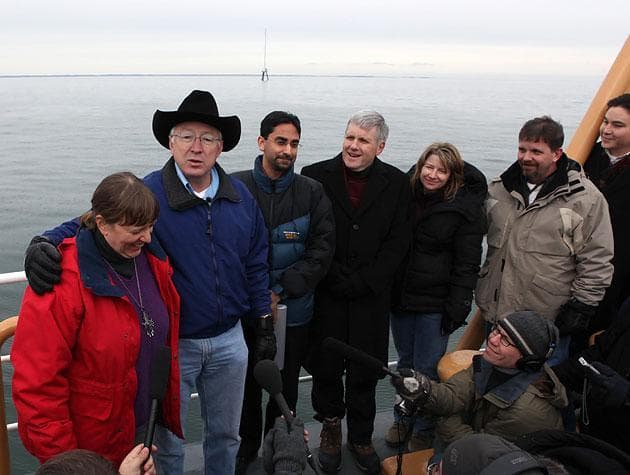Advertisement
Salazar's Cape Wind Decision Is Difficult, For A Consensus Builder
Resume
The fate of Cape Wind, a proposed $900 million wind farm in Nantucket Sound, likely rests with one man: U.S. Interior Secretary Ken Salazar.
Salazar recently toured the sound, in his trademark cowboy hat, and set his sights on a conclusion to a saga that has lasted a decade. He imposed a March 1 deadline for developers and opponents to reach an agreement. With no signs of public progress, the decision could fall to him.
For Bay Staters, that poses a question: Who is Ken Salazar?
Michael Riley, of The Denver Post's Washington bureau, said Salazar's Nantucket Sound tour typifies the Colorado native.
"One of the things that he's famous for is that if there are very, very sticky, difficult problems, he just wades in there," Riley told WBUR. "He shows up personally, tries to talk to all the parties involved, he tries to see if he can find some sort of middle ground."
Salazar honed his "middle ground" style in his home state. He was Colorado's attorney general and spent four years as its U.S. senator before being tapped by President Obama. Riley said Salazar appealed to a wide variety of constituencies with his folksy image. A precursor to Sen. Scott Brown, Salazar drove through Colorado in his pickup truck while campaigning for Senate.
"Certainly when he was in Colorado, he was known for being the kind of politician who could play very much to the middle," Riley said. "Colorado was known as a red state for a long time and has been leaning blue, and Ken Salazar has played a big role in that."
"It’s a big part of the Obama agenda, and it’s not something he’s going to let go of easily."
--Michael Riley, The Denver Post
Salazar used this moderate stance to forge consensus on issues of judicial nominations and immigration in the Senate. Since becoming interior secretary, Salazar carved a deal with Pennsylvania landowners over a 9/11 memorial and settled a civil suit brought by Native Americans against the federal government.
Cape Wind, however, presents a challenge to Salazar's penchant for consensus. He has recast the focus of the Interior Department upon renewable energy, a move that has squared him against oil and gas interests.
"Under the Obama administration he has indeed, I think, taken a more aggressive line in many issues that suggest renewable energy and wind power on public lands is a big part of his priorities and his agenda in the Interior Department," Riley said. "It's a big part of the Obama agenda, and it's not something he's going to let go of easily."
But the Cape Wind decision gets more complicated for Salazar, because opposition to the project does not end with local residents. Two American Indian tribes, the Aquinnah and Mashpee Wampanoag, say the proposed 130 wind turbines would disturb ancient rituals and burial grounds.
"He's been, of interior secretaries, an interior secretary that's really taken Native Americans, their issues and the things that they want addressed seriously," Riley said. "So it wasn't a surprise to see him go to Massachusetts to talk to some of the leaders of the Native American communities there to really try to listen."
Riley does not see easy decisions awaiting Salazar — on Cape Wind or throughout his tenure. "He is in a tough spot, and it's not just here," Riley said. "He's in a tough spot with renewable energy on public lands in general."
But Riley thinks the secretary will make a decision and won't waver.
Riley cautiously predicted Salazar would approve the project. "Based on everything we have seen at the Interior Department, this is a keystone to sort of moving forward," Riley said. "If I had to take a guess, I think that's where it comes down."
Click "Listen Now" to hear the full interview with Denver Post reporter Michael Riley.
This program aired on February 22, 2010.